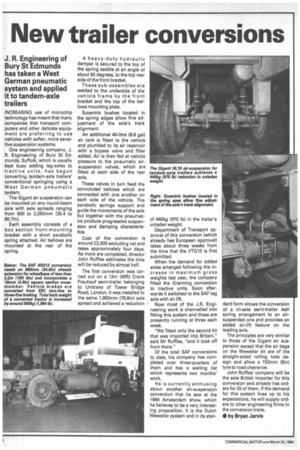New trailer conversions
Page 42

If you've noticed an error in this article please click here to report it so we can fix it.
INCREASING use of microchip technology has meant that many companies that transport computers and other delicate equipment are preferring to use vehicles with softer, more sensitive suspension systems.
One engineering company, J.
R. Engineering of Bury St Edmunds, Suffolk, which is usually kept busy adding tag-axles to tractive units, has begun converting tandem-axle trailers' conventional springing using a West German pneumatic System.
The Gigant air suspension can be mounted on any round-beam axle with axle spreads ranging from 900 to 2,050mm (35.4 to 80.7in).
Each assembly consists of a box section front-mounting bracket with a short parabolic spring attached. Air bellows are mounted at the rear of the spring. A heavy-duty hydraulic damper is secured to the top of the spring saddle at an angle of about 60 degrees, to the top rear side of the front bracket.
These sub-assembles are welded to the underside of the vehicle frame by the front bracket and the top of the bellows mounting plate.
Eccentric bushes located in the spring edges allow fine adjustment of the axle's track alignment.
An additional 40-litre (8.8 gal) air tank is fitted to the vehicle and plumbed to its air reservoir with a bypass valve and filter added. Air is then fed at vehicle pressure to the pneumatic airsuspension valves, which are fitted at each side of the rear axle.
These valves in turn feed the convoluted bellows which are connected with one another on each side of the vehicle. The parabolic springs support and guide the movements of the axle but together with the pneumatics produce progressive suspension and damping characteristics.
Cost of the conversion is around £2,000 excluding vat and takes approximately four days. As more are completed, director John Ruffles estimates the time will be reduced by almost half.
The first conversion was carried out on a 12m (40ft) Crane Freuhauf semi-trailer belonging to Unitrans of Tower Bridge Road, London. It was installed to the same 1,950mm (76.8in) axle spread and achieved a reduction of 440kg (970 lb) in the trailer's unladen weight.
Department of Transport ap proval of this conversion (which already has European approval) takes about three weeks from the time that the VTG10 is first submitted.
When the demand for added axles emerged following the increase in maximum gross weights last year, the company fitted the Granning conversion to tractive units. Soon sfterwards it switched to the SAF tag axle with air lift.
Now most of the J.R. Engi neering work is channelled into fitting this system and these are presently running at three each week.
"We fitted only the second kit that was imported into Britain," said Mr Ruffles, "and it took off from there."
Of the total SAF conversions to date, his company has completed over three-quarters of them and has a waiting list which represents two months' work.
He is currently enthusing about another air-suspension conversion that he saw at the 1984 Amsterdam show, which he believes to be a very interesting proposition. It is the Dutch Weweiler system and in its stan dard form allows the conversion of a tri-axle semi-trailer leafspring arrangement to an airsuspended one and provides an added air-lift feature on the leading axle.
The principles are very similar to those of the Gigant air suspension except that the air bags on the Wevveller kit are of the straight-sided rolling lobe design and allow a 152mm (6in) tyre to road clearance.
John Ruffles' company will be the sole British importer for this conversion and already has orders for 20 of them. If the demand for this system lives up to his expectations, he will supply orders to other engineering firms in the conversion trade.
• by Bryan Jarvis
























































































